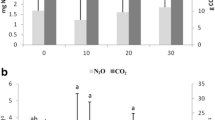Abstract
Gases are produced from wetlands when plant biomass is degraded by microbial consortia, producing carbon dioxide aerobically and methane when oxygen is lacking. In anaerobic waterlogged situations, such as the catotelm of ombrotrophic bogs, this methane forms minute gas bubbles that severely reduce the hydraulic conductivity and hence the degradation of biomass due to the lack of nutrients. The bogs thus become carbon sinks, formed from the partially degraded biomass that accumulates as peat. The results of an investigation of an ombrotrophic bog, Mer Bleue, Ontario, Canada are summarized here, and the effects that climate change may have on such bogs are discussed. Any change of the water table in wetlands will have a substantial effect upon their ecology. If the water table should fall allowing bogs to become aerobic, most of the accumulated biomass carbon could be returned to the atmosphere by degradation to carbon dioxide, and as well, methane entrapped within the matrix would be released directly to the atmosphere. If on the other hand, the bogs are flooded, then the entrapped bubbles will coalesce allowing the gas to escape to the atmosphere, while at the same time the degradation of the peat will be enhanced.
Similar content being viewed by others
References
Brown, D.A.: 1989, ‘Methane production in Canadian muskeg bogs’, PhD. Thesis, University of Ottawa, Canada.
Brown, D.A., and Overend, R.P.: 1993, ‘Methane metabolism in raised bogs of northern wetlands’, Geomicrobiol. J., 11, 35–48.
Brown, A., Mathur, S.P., and Kushner, D.J.: 1989, ‘An ombrotrophic bog as a methane reservoir’, Global Biogeochem. Cycles, 3, 205–213.
Brown, D.A., Mathur, S.P., Brown, A., and Kushner, D.J.: 1990, ‘Relationships between some properties of organic soils from the southern Canadian Shield’, Can. J. Soil Sci., 70, 363–377.
Crill, P.M., Bartlett, K.B., Harriss, R.E., Gorham, E., Verry, E.S., Sebacher, D.I., Madzar, L. and Sanner, W.: 1988, ‘Methane flux from Minnesota peatlands’, Global Biogeochem. Cycles, 2, 371–384.
Dinel, J., Mathur, S.P., Brown, A., and Levesque, M.: 1988, ‘A field study of the effect of depth on methane production in peatland waters: Equipment and preliminary results’, J. Ecol., 76, 1083–1091.
Reynolds, W.D., Brown, D.A., Mathur, S.P., and Overend, R.P.: 1992, ‘Effect of in-situ gas accumulation on the hydraulic conductivity of peat’, Soil Sci., 153, 397–408.
Roslev, P., and King, G.M.: 1996, ‘Regulation of methane oxidation in a freshwater wetland by water table changes and anoxia’, FEMS Microbiol. Ecol., 19, 105–115.
Rouse, W.R., Holland, S., and Moore, T.R.: 1995, ‘Variability in methane emissions from wetlands at northern treeline near Churchill, Manitoba, Canada’, Arctic Alpine Res., 27, 146–156.
Rudd, J.W.M., Harris, R., Kelly, C.A., and Hechy, R.E.: 1993, ‘Are hydroelectric reservoirs significant sources of greenhouse gases?’ Ambio, 22, 246–248.
Author information
Authors and Affiliations
Rights and permissions
About this article
Cite this article
Brown, D.A. Gas Production from an Ombrotrophic Bog-Effect of Climate Change on Microbial Ecology. Climatic Change 40, 277–284 (1998). https://doi.org/10.1023/A:1005421004276
Issue Date:
DOI: https://doi.org/10.1023/A:1005421004276




